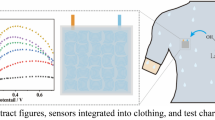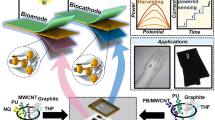Abstract
Flexible, wearable biosensors have been extensively investigated in recent decades due to their potential applications in portable electronics and human health monitoring. However, low sensitivity and complex fabrication are still great challenges for flexible sensors. Herein, a flexible electrochemical biosensor for glucose was proposed, which was based on reduced graphene oxide and gold nanoparticle-modified screen-printed gold electrodes (rGO-Au/SPGE) as catalysts and gel instead of traditional liquid electrolyte. The biosensor combines the soft stretchability of the gel, the specific selectivity of glucose oxidase (GOx) and the high catalytic activity of the rGO-Au/SPGE nanocomposite. More importantly, the soft gel not only adheres well to the skin, but also promotes the penetration of water-soluble molecules, effectively improving the accumulation of bodily fluids on dry skin surfaces. The constructed GOx-gel-rGO-Au/SPGE biosensor maintains stable sensing performance even after 1000 bending cycles. In addition, the biosensor exhibited significantly current response to glucose at a detection range of 1.25–850 µM and 0.85–7.72 mM (covers the glucose level in human sweat), with a sensitivity of 53.7 and 27.4 μA/mM cm2 and low detection limit (1.25 µM). The flexible electrochemical biosensor based on GOx-gel-rGO-Au/SPGE could accurately determine glucose in human sweat, demonstrating a promising feature for personal healthcare diagnosis.
Graphical abstract







Similar content being viewed by others
References
Lou Z, Wang L, Jiang K, Wei Z, Shen G (2020) Reviews of wearable healthcare systems: materials, devices and system integration. Mater Sci Eng: R: Rep 140:100523. https://doi.org/10.1016/j.mser.2019.100523
Yoon J, Lee SN, Shin MK, Kim HW, Choi HK, Lee T, Choi JW (2019) Flexible electrochemical glucose biosensor based on GOx/gold/MoS2/gold nanofilm on the polymer electrode. Biosens Bioelectron 140:111343. https://doi.org/10.1016/j.bios.2019.111343
Shi C, Zou Z, Lei L, Zhu Z, Zhang Z, Xiao X (2020) Heterogeneous integration of rigid, soft, and liquid materials for self-healable, recyclable, and reconfigurable wearable electronics. Sci Adv 6(45):eabd0202. https://doi.org/10.1126/sciadv.abd0202
Ling Y, An T, Yap LW, Zhu B, Gong S, Cheng W (2020) Disruptive, soft, wearable sensors. Adv Mater 32(18):e1904664. https://doi.org/10.1002/adma.201904664
Yetisen AK, Martinez-Hurtado JL, Unal B, Khademhosseini A, Butt H (2018) Wearables in medicine. Adv Mater 30:e1706910. https://doi.org/10.1002/adma.201706910
Bariya M, Nyein HYY, Javey A (2018) Wearable sweat sensors. Nat Electron 1(3):160–171. https://doi.org/10.1038/s41928-018-0043-y
Vashist SK (2012) Non-invasive glucose monitoring technology in diabetes management: a review. Anal Chim Acta 750:16–27. https://doi.org/10.1016/j.aca.2012.03.043
Scully T (2012) Diabetes in numbers. Nature 485(7398):S2–S3. https://doi.org/10.1038/485s2a
Xiong C, Zhang T, Kong W, Zhang Z, Qu H, Chen W, Wang Y, Luo L, Zheng L (2018) ZIF-67 derived porous Co3O4 hollow nanopolyhedron functionalized solution-gated graphene transistors for simultaneous detection of glucose and uric acid in tears. Biosens Bioelectron 101:21–28. https://doi.org/10.1016/j.bios.2017.10.004
Zahed MA, Barman SC, Das PS, Sharifuzzaman M, Yoon HS, Yoon SH, Park JY (2020) Highly flexible and conductive poly (3, 4-ethylene dioxythiophene)-poly (styrene sulfonate) anchored 3-dimensional porous graphene network-based electrochemical biosensor for glucose and pH detection in human perspiration. Biosens Bioelectron 160:112220. https://doi.org/10.1016/j.bios.2020.112220
Gong JP, Katsuyama Y, Kurokawa T, Osada Y (2003) Double-network hydrogels with extremely high mechanical strength. Adv Mater 15(14):1155–1158. https://doi.org/10.1002/adma.200304907
Sun JY, Zhao X, Illeperuma WR, Chaudhuri O, Oh KH, Mooney DJ, Vlassak JJ, Suo Z (2012) Highly stretchable and tough hydrogels. Nature 489(7414):133–136. https://doi.org/10.1038/nature11409
Ramadoss P, Rahman MI, Perumal A, Nallaiyan R, Basha SH, Dakshanamoorthy A (2020) Non-invasive, non-enzymatic, biodegradable and flexible sweat glucose sensor and its electrochemical studies. ChemistrySelect 5(36):11305–11321. https://doi.org/10.1002/slct.202002622
Gao W, Emaminejad S, Nyein HYY, Challa S, Chen K, Peck A, Fahad HM, Ota H, Shiraki H, Kiriya D, Lien DH, Brooks GA, Davis RW, Javey A (2016) Fully integrated wearable sensor arrays for multiplexed in situ perspiration analysis. Nature 529(7587):509–514. https://doi.org/10.1038/nature16521
Park J, Sempionatto JR, Kim J, Jeong Y, Gu J, Wang J, Park I (2020) Microscale biosensor array based on flexible polymeric platform toward lab-on-a-needle: real-time multiparameter biomedical assays on curved needle surfaces. ACS Sens 5(5):1363–1373. https://doi.org/10.1021/acssensors.0c00078
Park J, Jeong Y, Kim J, Gu J, Wang J, Park I (2020) Biopsy needle integrated with multi-modal physical/chemical sensor array. Biosens Bioelectron 148:111822. https://doi.org/10.1016/j.bios.2019.111822
Sasaki M, Karikkineth BC, Nagamine K, Kaji H, Torimitsu K, Nishizawa M (2014) Highly conductive stretchable and biocompatible electrode-hydrogel hybrids for advanced tissue engineering. Adv Healthc Mater 3(11):1919–1927. https://doi.org/10.1002/adhm.201400209
Kiani A, Asempour H (2012) Hydrogel membranes based on gum tragacanth with tunable structures and properties. II. Comprehensive characterization of the swelling behavior. J Appl Polym Sci 126(1):E478–E485. https://doi.org/10.1002/app.36782
Zhang Z, Fu H, Li Z, Huang J, Xu Z, Lai Y, Qian X, Zhang S (2022) Hydrogel materials for sustainable water resources harvesting & treatment: synthesis, mechanism and applications. Chem Eng J 439:135756. https://doi.org/10.1016/j.cej.2022.135756
Yan C, Kramer PL, Yuan R, Fayer MD (2018) Water dynamics in polyacrylamide hydrogels. J Am Chem Soc 140(30):9466–9477. https://doi.org/10.1021/jacs.8b03547
Zhou Y, Ma M, He H, Cai Z, Gao N, He C, Chang G, Wang X, He Y (2019) Highly sensitive nitrite sensor based on AuNPs/RGO nanocomposites modified graphene electrochemical transistors. Biosens Bioelectron 146:111751. https://doi.org/10.1016/j.bios.2019.111751
Tao T, Zhou Y, Ma M, He H, Gao N, Cai Z, Chang G, He Y (2021) Novel graphene electrochemical transistor with ZrO2/rGO nanocomposites functionalized gate electrode for ultrasensitive recognition of methyl parathion. Sens Actuators B: Chem 328:128936. https://doi.org/10.1016/j.snb.2020.128936
Xu D, Zhu C, Meng X, Chen Z, Li Y, Zhang D, Zhu S (2018) Design and fabrication of Ag-CuO nanoparticles on reduced graphene oxide for nonenzymatic detection of glucose. Sens Actuators, B Chem 265:435–442. https://doi.org/10.1016/j.snb.2018.03.086
Liu X, Zhang W, Lin Z, Meng Z, Shi C, Xu Z, Yang L, Liu X (2021) Coupling of silk fibroin nanofibrils enzymatic membrane with ultra-thin PtNPs/graphene film to acquire long and stable on-skin sweat glucose and lactate sensing small. Methods 5(3):2000926. https://doi.org/10.1002/smtd.202000926
Gao N, He C, Ma M, Cai Z, Zhou Y, Chang G, Wang X, He Y (2019) Electrochemical co-deposition synthesis of Au-ZrO2-graphene nanocomposite for a nonenzymatic methyl parathion sensor. Anal Chim Acta 1072:25–34. https://doi.org/10.1016/j.aca.2019.04.043
Zhao Y, Zhai Q, Dong D, An T, Gong S, Shi Q, Cheng W (2019) Highly stretchable and strain-insensitive fiber-based wearable electrochemical biosensor to monitor glucose in the sweat. Anal Chem 91(10):6569–6576. https://doi.org/10.1021/acs.analchem.9b00152
Bai Y, Chen B, Xiang F, Zhou J, Wang H, Suo Z (2014) Transparent hydrogel with enhanced water retention capacity by introducing highly hydratable salt. Appl Phys Lett 105(15):151903. https://doi.org/10.1063/1.4898189
Zheng L, Liu Y, Zhang C (2021) A sample-to-answer, wearable cloth-based electrochemical sensor (WCECS) for point-of-care detection of glucose in sweat. Sens Actuators B: Chem 343:130131. https://doi.org/10.1016/j.snb.2021.130131
Naik AR, Zhou Y, Dey AA, Arellano DLG, Okoroanyanwu U, Secor EB, Hersam MC, Morse J, RothsteinCarter JPKR (2022) Printed microfluidic sweat sensing platform for cortisol and glucose detection. Lab Chip 22(1):156–169. https://doi.org/10.1039/d1lc00633a
Cardoso RM, Silva PRL, Lima AP, Rocha DP, Oliveira TC, do Prado TM, Fava EL, Fatibello-Filho O, Richter EM, Muñoz RAA (2020) 3D-Printed graphene/polylactic acid electrode for bioanalysis: biosensing of glucose and simultaneous determination of uric acid and nitrite in biological fluids. Sens Actuators B: Chem 307:127621. https://doi.org/10.1016/j.snb.2019.127621
Zhai Q, Gong S, Wang Y, Lyu Q, Liu Y, Ling Y, Wang J, Simon GP, Cheng W (2019) Enokitake mushroom-like standing gold nanowires toward wearable noninvasive bimodal glucose and strain sensing. ACS Appl Mater Interfaces 11(10):9724–9729. https://doi.org/10.1021/acsami.8b19383
Myndrul V, Coy E, Babayevska N, Zahorodna V, Balitskyi V, Baginskiy I, Gogotsi O, Bechelany M, Giardi MT, Iatsunskyi I (2022) MXene nanoflakes decorating ZnO tetrapods for enhanced performance of skin-attachable stretchable enzymatic electrochemical glucose sensor. Biosens Bioelectron 207:114141. https://doi.org/10.1016/j.bios.2022.114141
Khumngern S, Jirakunakorn R, Thavarungkul P, Kanatharana P, Numnuam A (2021) A highly sensitive flow injection amperometric glucose biosensor using a gold nanoparticles/polytyramine/Prussian blue modified screen-printed carbon electrode. Bioelectrochemistry 138:107718. https://doi.org/10.1016/j.bioelechem.2020.107718
Lipińska W, Siuzdak K, Karczewski J, Dołęga A, Grochowska K (2021) Electrochemical glucose sensor based on the glucose oxidase entrapped in chitosan immobilized onto laser-processed Au-Ti electrode. Sens Actuators B: Chem 330:129409. https://doi.org/10.1016/j.snb.2020.129409
Wu M, Zhang Q, Fang Y, Deng C, Zhou F, Zhang Y, Wang X, Tang Y, Wang Y (2021) Polylysine-modified MXene nanosheets with highly loaded glucose oxidase as cascade nanoreactor for glucose decomposition and electrochemical sensing. J Colloid Interface Sci 586:20–29. https://doi.org/10.1016/j.jcis.2020.10.065
Li M, Wang L, Liu R, Li J, Zhang Q, Shi G, Li Y, Hou C, Wang H (2021) A highly integrated sensing paper for wearable electrochemical sweat analysis. Biosens Bioelectron 174:112828. https://doi.org/10.1016/j.bios.2020.112828
Acknowledgements
This work was supported by the National Natural Science Foundation of China (Nos. 51672074, 52272106), the Natural Science Foundation of Hubei Province, China (No. 2019CFA006), and the Program for Science and Technology Innovation Team in Colleges of Hubei Province (No. T201901).
Funding
National Natural Science Foundation of China, 52272106, Gang Chang, 51672074, Gang Chang, Natural Science Foundation of Hubei Province, 2019CFA006, Yunbin He, the Program for Science and Technology Innovation Team in Colleges of Hubei Province, T201901, Yunbin He.
Author information
Authors and Affiliations
Corresponding authors
Ethics declarations
Conflict of interest
The authors declare that they have no known competing financial interests or personal relationships that could have appeared to influence the work reported in this paper.
Additional information
Handling Editor: Annela M. Seddon.
Publisher's Note
Springer Nature remains neutral with regard to jurisdictional claims in published maps and institutional affiliations.
Supplementary Information
Below is the link to the electronic supplementary material.
Rights and permissions
Springer Nature or its licensor (e.g. a society or other partner) holds exclusive rights to this article under a publishing agreement with the author(s) or other rightsholder(s); author self-archiving of the accepted manuscript version of this article is solely governed by the terms of such publishing agreement and applicable law.
About this article
Cite this article
Gao, N., Cai, Z., Chang, G. et al. Non-invasive and wearable glucose biosensor based on gel electrolyte for detection of human sweat. J Mater Sci 58, 890–901 (2023). https://doi.org/10.1007/s10853-022-08095-7
Received:
Accepted:
Published:
Issue Date:
DOI: https://doi.org/10.1007/s10853-022-08095-7




